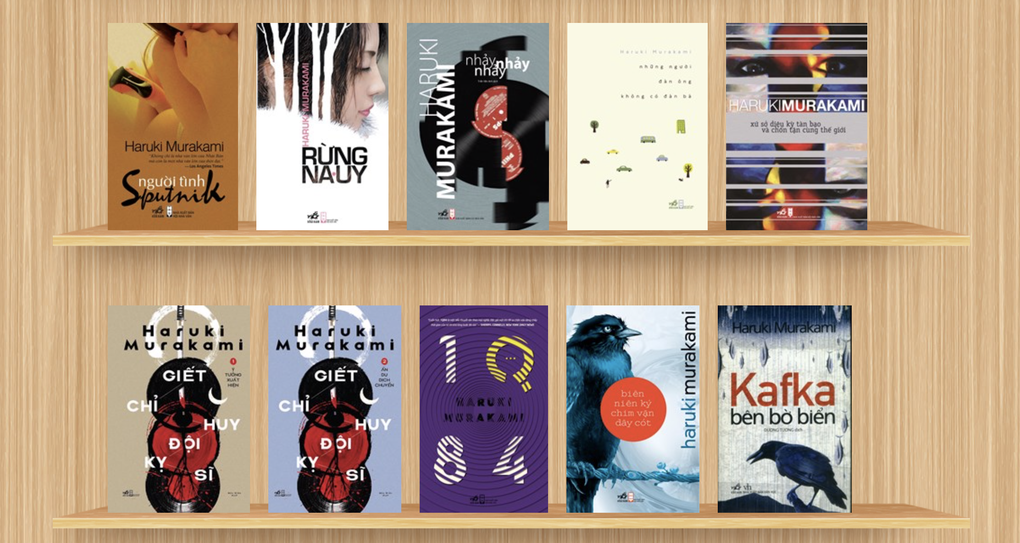Haruki Murakami, 74, is a best-selling novelist in Japan. He began his writing career at the age of 30 and became a literary phenomenon in 1987 when his fifth novel, Norwegian Wood, was published.
Haruki Murakami's blend of realistic and fantastical stories has earned him a huge fan base. His name is often mentioned as a candidate for the Nobel Prize in Literature.

Portrait of Haruki Murakami (Design: The Guardian).
Books for beginners
Murakami's novels can be divided into two categories: fantasy and realism. Many fall somewhere in between.
Published in 1987, Norwegian Wood is a simple memoir of young love. Landing on a runway in Germany, narrator Toru Watanabe hears a famous song by The Beatles, feeling transported back to his college years and tumultuous love affairs with two girls.
Nostalgic and sweet, Norwegian Wood is Murakami's most accessible novel and the book that "turned" the author into a literary superstar in Japan.

Cover of the book "Norwegian Wood".
If you only read one book by Haruki Murakami
The Wind-Up Bird Chronicle is considered Murakami's masterpiece.
Toru Okada (in his 30s, unemployed) searches for his missing cat. His wife also goes missing as he sleepwalks into a wild chase of increasingly bizarre events. He declares: "The best way to think about reality is to 'get as far away from it as possible'".
Abstract, infuriating, and downright funny, these are the most appealing aspects of Murakami's work.
If you are in a hurry
According to The Guardian , if you want to make a critically acclaimed film, adapt a Murakami short story.
The Korean thriller Burning was based on Murakami's Barn Burning . Ryusuke Hamaguchi recently won an Academy Award for his film adaptation of Murakami's book Drive My Car .
Some of Murakami's best storytelling can be found in some of his other works, such as Sleep , published in the New Yorker in 1992 and included in the short story collection The Elephant Vanishes .
In Sleep , Murakami writes for the first time from a woman's perspective. The story follows a devoted wife who suffers from insomnia. The work is praised for its use of the darkness of night to evoke the insecurity of being a woman in a patriarchal society.

Some works of Haruki Murakami published by Nha Nam in Vietnam (Screenshot).
Memoirs
Murakami's biography could be the plot for one of his main characters. He used to run a jazz club, turned 30 and quit to become a novelist.
Murakami's slim memoir, What I Talk About When I Talk About Running , offers an insight into his writing practice.
“Most of what I know about writing, I learned through running every day,” Murakami explains.
Murakami only took up running seriously in his 30s, reflecting on the comparisons between marathon running and writing. He also noted that training as a daily routine builds endurance and sometimes leads to injury.
The book is worth your time reading.
At three volumes and over a thousand pages, 1Q84 is Murakami's most ambitious novel to date.
1Q84 has a maze-like structure, which some critics complained was "disappointing" when it was first published in 2011. The novel's length may intimidate casual Murakami readers.
But when you step into the world of 1Q84, you will be treated to a horror film, a tender love story, a profound mystery, and a meditation on the metaphysical mysteries of a world unlike our own.
The book deserves more attention.
After its English-language publication in 2001, Sputnik Sweetheart fell out of the orbit of Murakami's more famous works.
The story contains a familiar theme in Murakami's world: the disappearing woman.
Narrated through the eyes of a typical Murakami narrator (male, fragile, passive), Sputnik Sweetheart is at the heart of the lesbian romance between Sumire (who wants to be a novelist like Jack Kerouac) and Miu (a refined, older woman).
Falling in love with Miu, Sumire begins to shed her wild exterior, transforming herself into Miu's chic personal assistant. The unequal romance soon turns destructive when Sumire... disappears.

A scene from the play adapted from the novel "Kafka on the Shore" (Photo: The New York Time).
Masterpiece
Unlike Murakami's typical 30-something, whiskey-drinking, jazz-listening protagonists, Kafka on the Shore is narrated by 15-year-old runaway Kafka Tamura.
Fleeing from his abusive father after receiving a prophecy, Kafka finds refuge by working in a library in a small coastal town.
Interspersed with Kafka's story is the story of Satoru Nakata, an elderly man who lost his childhood memories at the end of World War II, but instead gains the ability to converse with cats.
Nakata is forced to go on the run after encountering a vicious cat catcher named Johnnie Walker.
Murakami says the urgency behind his stories is "losing, searching, and finding." Kafka on the Shore demonstrates the author's ability to create a dreamlike labyrinth.
Source link



![[Photo] General Secretary To Lam attends the conference to review 10 years of implementing Directive No. 05 of the Politburo and evaluate the results of implementing Regulation No. 09 of the Central Public Security Party Committee.](https://vphoto.vietnam.vn/thumb/1200x675/vietnam/resource/IMAGE/2025/5/19/2f44458c655a4403acd7929dbbfa5039)
![[Photo] Panorama of the Opening Ceremony of the 43rd Nhan Dan Newspaper National Table Tennis Championship](https://vphoto.vietnam.vn/thumb/1200x675/vietnam/resource/IMAGE/2025/5/19/5e22950340b941309280448198bcf1d9)
![[Photo] Close-up of Tang Long Bridge, Thu Duc City after repairing rutting](https://vphoto.vietnam.vn/thumb/1200x675/vietnam/resource/IMAGE/2025/5/19/086736d9d11f43198f5bd8d78df9bd41)

![[Photo] President Luong Cuong presents the 40-year Party membership badge to Chief of the Office of the President Le Khanh Hai](https://vphoto.vietnam.vn/thumb/1200x675/vietnam/resource/IMAGE/2025/5/19/a22bc55dd7bf4a2ab7e3958d32282c15)






























![[Photo] Prime Minister Pham Minh Chinh inspects the progress of the National Exhibition and Fair Center project](https://vphoto.vietnam.vn/thumb/1200x675/vietnam/resource/IMAGE/2025/5/19/35189ac8807140d897ad2b7d2583fbae)
























































![[VIDEO] - Enhancing the value of Quang Nam OCOP products through trade connections](https://vphoto.vietnam.vn/thumb/402x226/vietnam/resource/IMAGE/2025/5/17/5be5b5fff1f14914986fad159097a677)



Comment (0)